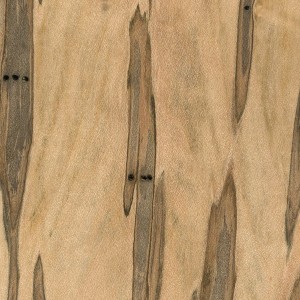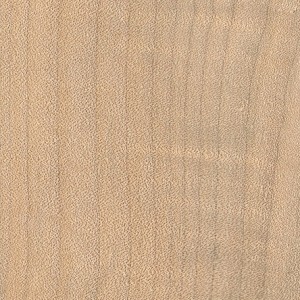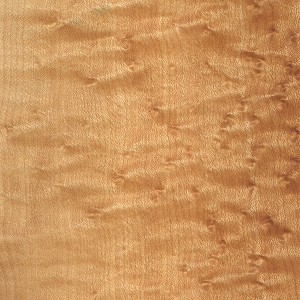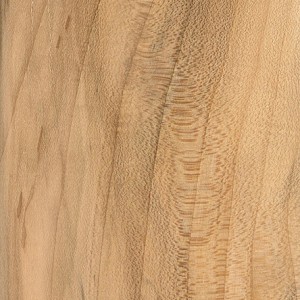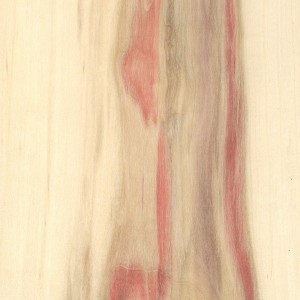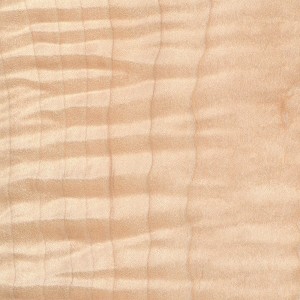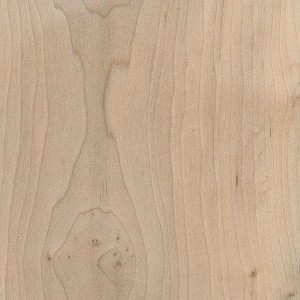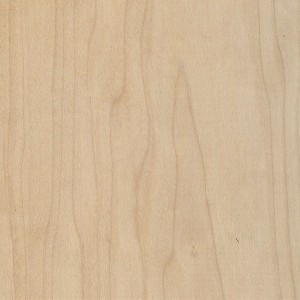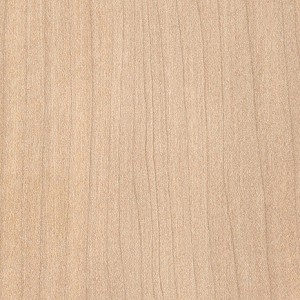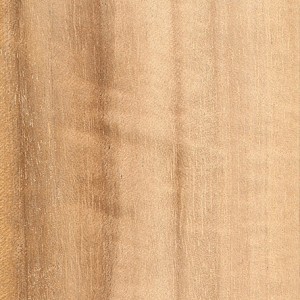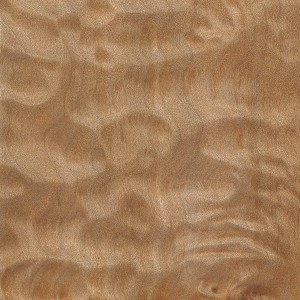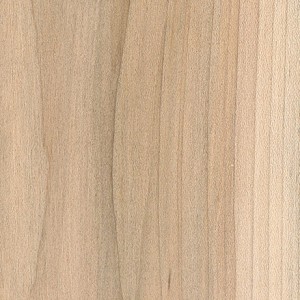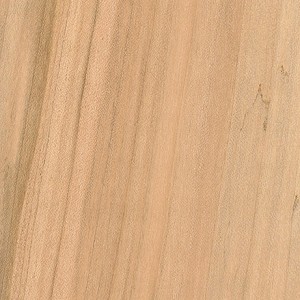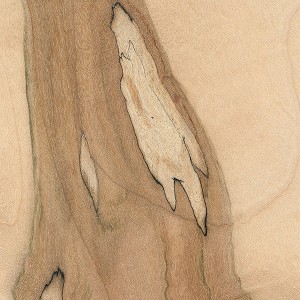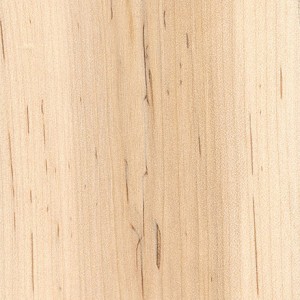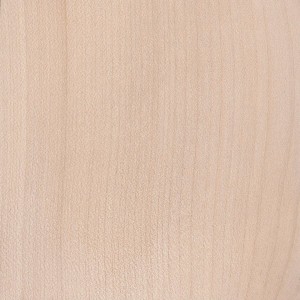The Maple Family
Is a description of any type of Maple that has been infested by ambrosia beetles. The beetles bore into the tree, and with it bring fungus that discolors the wood.
| Scientific Name: | Acer macrophyllum |
| Location: | coastal regions of Pacific North America |
| Dried Weight: | 34lbs/ft3 |
| Janka Hardness: | 850lbf |
| Crushing Strength: | 5,950lbf /in2 |
Unlike other hardwoods, the sapwood of maple is used most commonly. Big leaf Maple has a sapwood that ranges from almost white to a light golden or reddish brown color. The heartwood is a darker reddish brown. The grain is straight and it has a fine even texture. This maple is rated as non-durable to perishable in regards to decay. It is easy to work with and it has a tendency to burn when being machined with high speed cutters. The wood turns, glues, and finishes well.
Birdseye Maple is not technically a distinct species of Maple, but rather, it’s a figure that’s occasionally found in any hard maple species. The figure is reportedly caused by unfavorable growing conditions for the tree. The Maple attempts to start numerous new buds to get more sunlight, but with poor growing conditions the new shoots are aborted, and afterward a number of tiny knots remain.
| Scientific Name: | Acer nigrum |
| Location: | northeastern USA |
| Dried Weight: | 40lbs/ft3 |
| Janka Hardness: | 1,180lbf |
| Crushing Strength: | 6,680lbf /in2 |
Unlike other hardwoods, the sapwood of maple is used most commonly. Black Maple has a sapwood that ranges from almost white to a light golden or reddish brown color. The heartwood is a darker reddish brown. The grain is straight and it has a fine even texture. This maple is rated as non-durable to perishable in regards to decay. It is easy to work with and it has a tendency to burn when being machined with high speed cutters. The wood turns, glues, and finishes well.
| Scientific Name: | Acer negundo |
| Location: | North America |
| Dried Weight: | 30lbs/ft3 |
| Janka Hardness: | 720lbf |
| Crushing Strength: | 4,950lbf /in2 |
Box Elder Maple has a sapwood which is pale white, sometimes with a yellow/green hue. The heartwood is a grayish/yellowish brown color. The grain is straight and it has a fine even texture. The end grain is diffuse-porous. Box Elder is rated as non-durable to perishable in regards to decay. The wood is easy to work with and it turns, glues, and finishes well.
Curly Maple is not actually a species, but simply a description of a figure in the grain—it occurs most often in soft maples, but is also seen in hard maples. It is so called because the ripples in the grain pattern create a three dimensional effect that appears as if the grain has “curled” along the length of the board.
| Scientific Name: | Acer campestre |
| Location: | Europe |
| Dried Weight: | 43lbs/ft3 |
| Janka Hardness: | 1,150lbf |
| Crushing Strength: | not available |
Unlike other hardwoods, the sapwood of maple is used most commonly. Field Maple has a sapwood that ranges from almost white to a light golden or reddish brown color. The heartwood is a darker reddish brown. The grain is straight and it has a fine even texture. This maple is rated as non-durable to perishable in regards to decay. It is easy to work with and it has a tendency to burn when being machined with high speed cutters. The wood turns, glues, and finishes well.
| Scientific Name: | Acer saccharum |
| Location: | northeastern North America |
| Dried Weight: | 44lbs/ft3 |
| Janka Hardness: | 1,450lbf |
| Crushing Strength: | 7,830lbf /in2 |
Unlike other hardwoods, the sapwood of maple is used most commonly. Hard Maple has a sapwood that ranges from almost white to a light golden or reddish brown color. The heartwood is a darker reddish brown. The grain is straight and it has a fine even texture. The end grain is diffuse-porous. This maple is rated as non-durable to perishable in regards to decay. It is easy to work with and it has a tendency to burn when being machined with high speed cutters. The wood turns, glues, and finishes well.
| Scientific Name: | Acer platanoides |
| Location: | Europe & western Asia |
| Dried Weight: | 40lbs/ft3 |
| Janka Hardness: | 1,000lbf |
| Crushing Strength: | 8,560lbf /in2 |
Unlike other hardwoods, the sapwood of maple is used most commonly. Norway Maple has a sapwood that ranges from almost white to a light golden or reddish brown color. The heartwood is a darker reddish brown. The grain is straight and it has a fine even texture. This maple is rated as non-durable to perishable in regards to decay. It is easy to work with and it has a tendency to burn when being machined with high speed cutters. The wood turns, glues, and finishes well.
| Scientific Name: | Flindersia spp. |
| Location: | northern Queensland |
| Dried Weight: | 35lbs/ft3 |
| Janka Hardness: | 810lbf |
| Crushing Strength: | 6,810lbf /in2 |
Queensland maple has a heartwood which ranges from a yellow to golden or reddish brown. The color will darken with age. The sapwood is narrow and has a white color. The grain is interlocked and sometimes wavy and it has a medium to coarse texture. The wood gives off a good natural lustre. The end grain is diffuse-porous. Queensland is rated as non-durable in regards to decay. The wood is good to work with and turns, glues, and finishes well.
Quitled Maple is not actually a species, but simply a description of a figure in the grain. Quilted maple occurs most often in soft maples. Quilted maple is so named for its resemblance to patchwork patterns seen on fabric quilts.
| Scientific Name: | Acer rubrum |
| Location: | eastern North America |
| Dried Weight: | 38lbs/ft3 |
| Janka Hardness: | 950lbf |
| Crushing Strength: | 6,540lbf /in2 |
Unlike other hardwoods, the sapwood of maple is used most commonly. Red Maple has a sapwood that ranges from almost white to a light golden or reddish brown color. The heartwood is a darker reddish brown. The grain is straight and it has a fine even texture. This maple is rated as non-durable to perishable in regards to decay. It is easy to work with and it has a tendency to burn when being machined with high speed cutters. The wood turns, glues, and finishes well.
| Scientific Name: | Acer saccharinum |
| Location: | northeastern USA |
| Dried Weight: | 33lbs/ft3 |
| Janka Hardness: | 700lbf |
| Crushing Strength: | 5,220lbf /in2 |
Unlike other hardwoods, the sapwood of maple is used most commonly. Silver Maple has a sapwood that ranges from almost white to a light golden or reddish brown color. The heartwood is a darker reddish brown. The grain is straight and it has a fine even texture. This maple is rated as non-durable to perishable in regards to decay. It is easy to work with and it has a tendency to burn when being machined with high speed cutters. The wood turns, glues, and finishes well.
Splated Maple
Much like Ambrosia Maple and other forms of figured maple, Spalted Maple is technically not a specific species of Maple, but rather a general description of any type of Maple that has been allowed to begin initial stages of decay, and then subsequently dried. The partial decay, called spalting, gives the wood dark contrasting lines and streaks where fungus has begun to attack the wood. If the wood has been rescued from the spalting at the right time, the lumber should still be sound and usable, with little to no soft spots or rotten wood.
| Scientific Name: | Acer pensylvanicum |
| Location: | eastern North America |
| Dried Weight: | 32lbs/ft3 |
| Janka Hardness: | 770lbf |
| Crushing Strength: | not available |
Unlike other hardwoods, the sapwood of maple is used most commonly. Striped Maple has a sapwood that ranges from almost white to a light golden or reddish brown color. The heartwood is a darker reddish brown. The grain is straight and it has a fine even texture. This maple is rated as non-durable to perishable in regards to decay. It is easy to work with and it has a tendency to burn when being machined with high speed cutters. The wood turns, glues, and finishes well.
| Scientific Name: | Acer pseudoplatanus |
| Location: | Europe & southwestern Asia |
| Dried Weight: | 38lbs/ft3 |
| Janka Hardness: | 1,050lbf |
| Crushing Strength: | 7,980lbf /in2 |
Unlike other hardwoods, the sapwood of maple is used most commonly. Sycamore Maple has a sapwood that ranges from almost white to a light golden or reddish brown color. The heartwood is a darker reddish brown. The grain is straight and it has a fine even texture. This maple is rated as non-durable to perishable in regards to decay. It is easy to work with and it has a tendency to burn when being machined with high speed cutters. The wood turns, glues, and finishes well.
